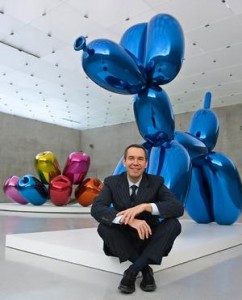
The Jeff Koons retrospective, currently on show at New York’s Whitney Museum of American Art, demonstrates the terrifying power of an art superstar to secure the impunity to make a lot of terrible work on the basis of a few great pieces. But to celebrate some pieces and revile others is to entirely miss the point of Koons’ body of work as grim reflection of some ineffable sickness.
It is difficult to judge the art of Jeff Koons without infection from its collateral damage: the astronomical prices, the vapid explanations, Koons’ nearly inhuman good nature, the photo-ops and reams of critical prose on how surprisingly essential his work is all billow a great smokescreen over the objects themselves. Furthermore, like all incandescent art superstars, Koons’ work has to be seen to be believed and given time to reveal itself on its own terms.
Koons vehemently insists on the inherent simplicity of his work, in that unfailingly polite, congenial way that a banker might assure you that your investments are safe. His work is all about the unforgiving postmodern melding of high and low culture, a mesh of minimalism and Pop Art that explores the liminal space between aesthetics and economics. It uses consumerism to make art that is about consumerism, with an entirely self-conscious flourish. The result is a body of work that is so simple that Koons can sincerely assert the glib emptiness of minimalism, while opening the floodgates to a rush of criticism that either insists on the hidden – near noumenal – complexity of the work or denounces it as a shallow realisation of how too much money corrodes culture.
The reality of it is that all of this is true at the same time. The works are pregnant with an unbearable emptiness, which might just be the human condition under late capitalism, and yet overflow with the zealous complexity of consumer culture. In 35 years, he has made so much work that you have to sift through the mud to find the gems, and just when your utter disgust is about to overwhelm you, the obscenity of it all is unexpectedly distilled into a near-spiritual sense that something important is being communicated.
The Balloon Dogs are what they are – big, shiny metal inflammations of a clown’s uninspiring party-piece – but when you stand before one of them the enormity and the gall of it become somehow sublime. You realise that Jeff Koons did not do this, he did not create something so garish and so ugly out of a cute party trick; the point, rather, is that capitalism did this, it took the banality of existence and trumped it up into something irresistible. After all, there are burgers, and there are the sickly sweet McDonald’s burgers. Koons has only tapped in to the way that capitalism magnifies simple desires several hundred times until they become dreams and then, as some kind of mortal insult, makes those dreams tangible, attainable.
Koons is nothing if not divisive. Although it is all shiny, happy renditions of popular culture, Koons’ work is difficult, not in the Kiefer sense, but in the sense of an offensive joke that you fully understand, but feel that your intellect is too soiled to laugh at. The Michael Jackson and Bubbles sculpture is as grotesque as the dizzying absurdity of the man himself, the Popeye works are cartoons made real and the Made in Heaven series is kitsch pornography on a Disney scale. You just don’t know whether to accept the initial awe as confirmation of artistic genius or to reject as cruel trick that stabs the veins at the heart of humanity. They are brilliant indictments of how we have become so obsessed with a mass media that exaggerates our desires to the point of absurdity, even if we feel an overwhelming nausea for the state of art when we encounter them.
But Koons earned the right to make art that disgusts by making works which beguile with their stark fusion of modern simplicity and postmodern nuance: the Equilibrium Tanks and Hoover pieces possess a silent elegance that gradually withers into a deafening clash of the tools of art history with bumbling idiocy of human nature. The Balloon Dogs also have this effect, so long as you can think through the pristine surface. But Jeff eschews thinking, he maintains it’s simple or spiritual or whatever because he doesn’t want you to realise that the comfort of millions of dollars have swaddled him against the crushing reality that his best work is behind him. And that, in a sense, is the great ruse of Koons’ art: deep down you know the difference between the good and the bad, but the bling of the city boy and the posturing of high-octane commercialism seduces you into looking seriously at all of it, as if the sheer enormity of all that money must – against all reason – mean something.
It’s not that Koons’ work is bad, or impossible to like or take seriously, it’s just that it is one-dimensional: great conceptual art is a case of its not what it looks like, since it looks like a defaced Goya but actually it is a harsh rejection of the notion of artistic genius; with Koons, it is what it looks like – is just and only is a very expensive, very ugly, very pure expression of the worst excesses of capitalism, consumerism and popular culture. Nothing more, nothing less. All the meaning is therefore contained within the object, to be discerned at a glance, and no amount of looking will reveal anything else, which is why venture capitalists with a transcendent lack of taste like it.
This simplicity and sincerity is the core of his art and, as such, makes it bizarrely honest in its mission and affect. The Balloon Dog is only as ugly as our own greed and our own inexplicable habit of mandating Koons’ behaviour by writing about him, taking about him and turning up to the Whitney to revel in the madness of it all. Koons’ mistake is not to make ugly art, but it is to be so frank about the fact that we have given up so much humanity to satisfy our manifold lusts through capitalism. The reason that only venture capitalists cab play with this balloon is simply that only they can afford it, and that is the purest expression of where Western societies are at right now.
Words: Daniel Barnes







